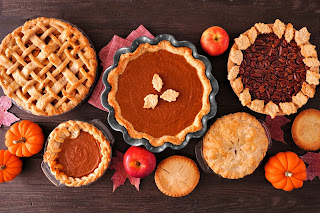 2024 was a shorter year in the kitchen for me. Due to some medical issues I didn't really start cooking until sometime in mid February, but once I got cooking I got lucky with some great dishes! Normally I only do about 10 top dishes for the year, but this year I have 12!
2024 was a shorter year in the kitchen for me. Due to some medical issues I didn't really start cooking until sometime in mid February, but once I got cooking I got lucky with some great dishes! Normally I only do about 10 top dishes for the year, but this year I have 12!
The dishes below aren't ranked from 1-12, but they are in calendar order of how I cooked them throughout the year, February thru December. If you click on the title of the recipe you'll be directed back to the original post with the recipe!
First up is How Sweet Eats Chicken and Bacon Ranch Puff Pastry Pizza. I truly love the puff pastry pizzas from How Sweet Eats. This version uses leftover chicken, or rotisserie chicken, with cheese, bacon, dill, scallions, and a drizzle of ranch dressing. If you love these flavors then this will be a big hit for you too! Easy enough for a weeknight, but delicious enough for a party or entertaining, you simply can't go wrong!
Next up is the dish I made more than anything else this year, How Sweet Eats Our Favorite Baked Cheesy Rice. I made this dish out of necessity because I was on a mild diet and we ended up loving the baked rice dish with bits of crispy sharp white cheddar on top and creamy white cheddar underneath. It became a staple dish everyone craved and went well with so many things. I bet I made it at least 25 times throughout the year!Why make one puff pastry pizza when you can make two? How Sweet Eats Puff Pastry Breakfast Pizza was also a grand slam in the breakfast department. Again, it's hard to go wrong with flaky puff pastry with eggs, bacon, cheese, and herbs! If you want something easy that is rather impressive first thing in the morning go with this recipe! It is dressed to impress and tastes delicious! Would be great for a Sunday breakfast, a girls brunch, or any situation where you need to entertain.How Sweet Eats Oreo Peanut Butter Pie is hands down THE BEST PEANUT BUTTER PIE we've ever had. I'm not the biggest Oreo fan, but Oreos do make for a great crust for the luscious peanut butter mousse that goes inside. The first day the peanut butter mousse is light and creamy, but after several hours in the fridge, or overnight, the peanut butter mousse gets thick and dense like cheesecake. When you top this pie with Oreos and peanut butter cups and whipped cream it is the most decadent and delicious of all desserts!
This favorites roundup is quickly becoming a How Sweet Eatspalooza, but her site offered many recipes I wanted to try and they all became instant hits! This One Pot Garlic Butter Shrimp and Orzo from How Sweet Eats was quick and delicious and we've had it a couple times since. I've noticed that people love quick shrimp dishes, as they tend to garner some of the most views on my site, so I wanted to include this one because it is a great weeknight dish!
This roundup makes it look like my family eats A LOT of puff pastry, but I can assure you we do not. It is always a hit though, and for a special treat these Cheeseburger Puff Pastry Pockets from How Sweet Eats are sure to be a favorite in your house too! What's not to like about savory beef and cheese pockets in a crispy-crunchety crust?
This Lemon Butter Chicken from How Sweet Eats is lemon forward, and you do have to like lemon, but the garlic and herbs also come front and center and the chicken bakes up so tender and flavorful. This is a healthy, quick, and delicious weeknight dinner that any lemon lover would adore.
I make a lot of regular ol' rice krispy treats, but I really love peanut butter so I wanted to try my hand at How Sweet Eats Salted Peanut Butter Rice Krispy Treats and it should be illegal how good these are. The balance of flavors is perfect and the peanut butter with the gooey marshamallow gives a this a fluffernutter feel. These are addictive and hard to stop eating!
This summer I made 10 wonderful ice cream recipes from The Gourmet Cookbook, but it was this recipe for Maple Walnut Ice Cream that stood out from the rest. I loved this recipe so much. The consistency of the ice cream and the subtle flavor of the maple syrup with the crunchy walnuts...it was heaven!
Who doesn't love a good meatball recipe? These Pesto Zuppa Toscana Meatballs from Half Baked Harvest are made with turkey and a pesto red sauce base with cheese on top and they were so good, and even better the next day. I enjoyed mine with some soft, fluffy naan bread, but they are also delicious on their own, and I bet just as good over pasta.
I knew Erin French's Glazed Butter Cake was going to be delicious, but it was mind-blowing delicious. Like probably ONE OF THE BEST DESSERTS I'VE EVER MADE! This isn't even my favorite type of dessert, but this is INCREDIBLE warm with whipped cream and berries. If you make any of the recipes on this post, make this one. It's just unbelievably delicious.
My last recipe of the year, Ina Garten's Buttermilk Cheddar Biscuits, was the perfect way to end a great year in the kitchen. The biscuits were soft and fluffy with yummy pockets of cheese and we gobbled them up for breakfast in no time.
I'm excited to see what 2025 brings and hope that next year is just as delicious!



















































